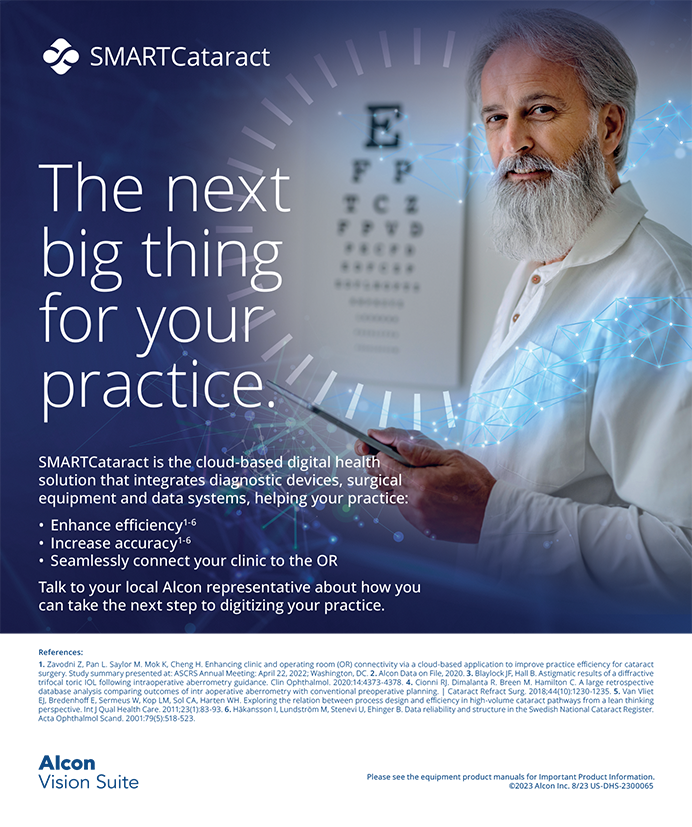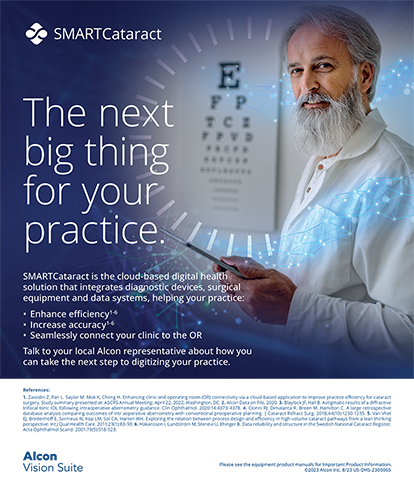I consider the option of refractive lens exchange (RLE) most actively for presbyopic hyperopes. Patients whose needs go beyond the limits of reading vision LASIK or monovision LASIK are the best candidates for this procedure.
The Tecnis Multifocal IOL (Abbott Medical Optics Inc., Santa Ana, CA) is my lens of choice for these types of patients, because in my experience, it best satisfies their demand: the ability to see clearly at distance and read at near.
APPROPRIATE CANDIDATES
To ensure success with RLE, I use my “rule of 8.” Depending upon the patient’s level of motivation, I may lower the score to less than 8. Strictly speaking, however, I proceed with RLE if the sum of the following categories adds up to 8 or more: the patient’s age in decades, his or her spherical equivalent in diopters, and the degree of nuclear sclerosis.
For example, if a patient is 55 years old (5.5), exhibits no nuclear sclerosis (0), and has 2.50 D of hyperopia (2.5), the score is 8 (5.5 + 0 + 2.5 = 8.0), which means a successful outcome for the patient is likely. If he or she is 30 years old, has no nuclear sclerosis, and has 3.00 D of hyperopia, LASIK is a far better option.
The nuclear sclerosis score comes into play for marginal patients. A 50-year-old with 20/20 BCVA and no complaints of glare, 1+ nuclear sclerosis, and 2.50 D of hyperopia would have a score of 8.5. He or she should be happy with RLE.
SURGICAL TECHNIQUE
An RLE technique should consist of a minimally invasive procedure, and typically, only very low phaco energy is needed in these eyes. It is also important to achieve a result as close to plano as possible. I find that ORange intraoperative wavefront aberrometer (WaveTec Vision, Aliso Viejo, CA) is indispensible in that setting, especially because many RLE patients tend to have a higher likelihood of previous LASIK or other refractive procedures. ORange helps me to better predict the lens’ power, and it is useful for guiding the placement of limbal relaxing incisions to correct astigmatism. Our center was the first to use the device clinically beginning 3 years ago.
ADDITIONAL CONSIDERATIONS
Surgeons should be prepared to enhance RLE results with LASIK. It is also imperative to understand the appropriate endpoint to target. RLE patients, perhaps more so than any other category of patients, place a premium on crisp vision. Ophthalmologists typically refract patients in a 20-foot examination lane and target plano. In reality, however, because 20 feet is roughly 6 meters, patients are left with 0.16 D of myopia. The IOL power calculation formulas are designed for refraction in an examination lane, at 20 feet, not for infinity. Residual myopia can negatively affect nighttime driving and other activities. I find that aiming for 0.16 D of hyperopia (relative to the IOL prediction formulas) results in crisper nighttime driving vision, because this provides patients with a true plano result at distance. This target also pushes the patient’s near add out a little farther so that, with a multifocal IOL, the reading distance is more comfortable.
Because RLE patients tend to be younger than those undergoing cataract surgery, the former are more likely to develop epiretinal membranes after surgery. It is important to keep these patients on anti-inflammatory agents for a longer duration than older cataract patients.
HAPPY PATIENTS
My patients’ level of satisfaction is extremely high. Many who come to my practice asking for LASIK are somewhat disappointed when I instead recommend RLE, so longer discussions are required. The flip side is that I also often see referred patients who request RLE, and they are disappointed when I recommend LASIK (in spite of the fact that RLE is more expensive).
Kerry K. Assil, MD, is a specialist in cataract and refractive surgery at the Assil Eye Institute in Beverly Hills and Santa Monica, California. He is a paid consultant to Abbott Medical Optics Inc. and WaveTec Vision. Dr. Assil may be reached at (310) 453-8911; kassil@assileye.com.


